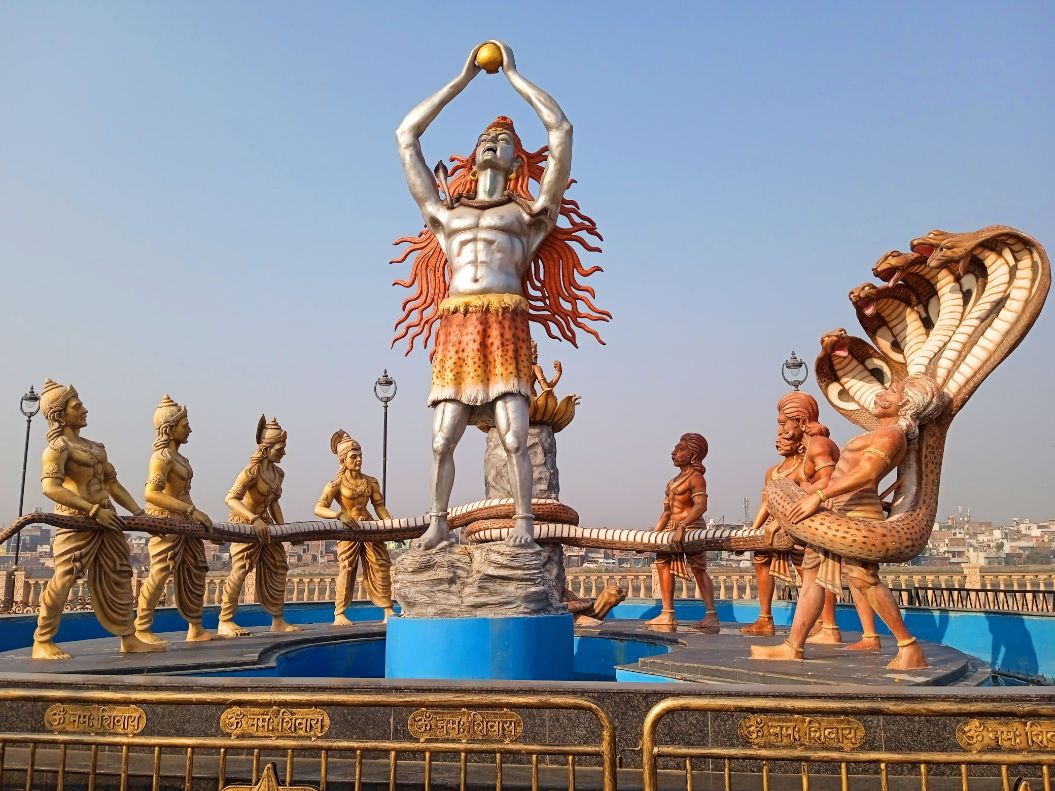- Where2Go
- Madhya Pradesh
- Ujjain
Ujjain
One of the seven sacred Hindu cities, Ujjain is located on the banks of river Kshipra and is land of the magnificent Kumbh Mela.
Iconic religious sites and a web of lively lanes are a vibrant display of Ujjain’s art and heritage.
Things To See & Do

Bhartrihari Caves
Saga of a Sage/ Abode of a Sage
1 to 2 hours
Suggested Time

Maharishi Sandipani Ashram
Gurukul of the Gods
1 hour
Suggested Time

Jantar Mantar
The Yantra Mahal
1 hour
Suggested Time

Kaliadeh Palace
A Historical Landmark
1 to 2 hours
Suggested Time

Shree Mahakaleshwar Temple
One Of The 12 Jyotirlingas
1 to 2 Hours
Suggested Time

Kalidasa Academy
A Homage to Kalidasa
1 to 2 hours
Suggested Time

Ram Mandir Ghat
The Ghat of Kumbha Simhastha
1 to 2 hours
Suggested Time

Chintaman Ganesh Temple Ujjain Madhya Pradesh
Ancient Temple of Peace and Prosperity
1-2 hours
Suggested Time

WWF Water Park and Resort
Experience the perfect blend of fun and relaxation
A full day or a ...
Suggested Time

Ujjain Simhastha Kumbha
India’s Largest Spiritual Gathering
3 to 4 hours
Suggested Time
Best Time To Visit Ujjain
Year round destination
OCT-MAR
Peak Season
APR-JUN
Moderate Season
JUL-SEP
Off-season
- Whattoexpect:Moderate weather.
- Thingsyou'lllove:Sightseeing and local cuisine.
FESTIVALS AND EVENTS
Book Your Trip to Ujjain
Travel Options to reach Ujjain
Our Recommendations
Train to Ujjain
10h 55m . One way
Booking Price
₹415
Flight to Indore Airport, then Car to Ujjain
Booking Options Starting From
₹6,308
Stay in Ujjain
Recommended Options
3 STAR HOTELS
Recommended For You
Average Price
₹2,585

The Byke Boutique - Mahakal Aangan - Ujjain
Suraj Nagar
₹2,515
Onwards

HOTEL KALPANA PALACE
Jaisinghpura
₹3,725
Onwards

HOTEL MYBUDGET
Kamri Marg
₹1,515
Onwards
4 STAR HOTELS
Recommended For You
Average Price
₹4,211

Casa Oro
Mahashweta Nagar
₹6,800
Onwards

Perfectstayz Premium Shree Narayana Ujjain
Pawapuri Colony
₹1,999
Onwards

Hotel Satyug
Kharakua Colony
₹3,835
Onwards
5 STAR HOTELS
Recommended For You
Average Price
₹5,088

MPT Samrat Vikramaditya The Heritage, Ujjain
Jaisinghpura
₹11,028
Onwards

Shree Balaji Hotel
Ujjain
₹1,722
Onwards

The Byke Boutique - Mahakal Aangan - Ujjain
Suraj Nagar
₹2,515
Onwards
Discover by Interest
Ujjain: A Sacred City in MP
Ujjain nestles by the Kshipra River in Madhya Pradesh. You will find many old temples and religious spots here. People from all over visit this holy city. It is one of the seven sacred Hindu cities. The Kumbh Mela happens here every twelve years.
The Ideal Time to Visit Ujjain
The best time to go Ujjainis from October to March. The weather stays nice and cool during these months.
Top Places to Visit in Ujjain
You must check out these five holy and old places when you come to Ujjain. Ujjain places to visit have their own story to tell you.
Shree Mahakaleshwar Temple
This temple has one of the twelve special Shiva shrines. You can see nice Maratha-styled building work here.
Bhartrihari Caves
These caves are on the river bank where a king once gave up his royal life. You can walk where he spent twelve years praying.
Kaliadeh Palace
A sultan built this palace in 1458 with pretty Persian designs. You can see the river flowing on both sides like an island.
Jantar Mantar
This old star-watching place helped wise men study the sky long ago. You can still see tools that work just by using sunlight.
Ram Mandir Ghat
This river bank hosts the big Kumbh Mela every twelve years. You might catch a pretty sunset here by the water.
The Top Things to Plan out in Ujjain
Try these four fun things in Ujjain besides just seeing temples. They will help you learn about the city's past.
Visiting Maharishi Sandipani Ashram
Lord Krishna learned here as a student long ago. You can visit the school that is now a temple.
Checking into Ujjain Simhastha Kumbha
This big holy fair brings millions of people every twelve years. You should plan ahead if you want to see this event.
Visiting Kalidasa Academy
This school studies old Sanskrit books and poems. You can walk around its big campus and learn new things.
Visit Chintaman Ganesh Temple
This old temple honours the elephant god Ganesha. You may find it calm and detach yourself from the humdrum of daily life.
How to Reach Ujjain?
You can get to Ujjain three ways. Pick the one that works best for your trip.
By Air
Fly to Indore first, then take a car to Ujjain. You need to travel about 54.9 km from the airport.
By Train
Catch a train to Ujjain Junction from nearby cities in Ujjain. You will find trains coming from various destinations.
By Road
You may take a bus to Ujjain from nearby towns. You can also find taxis available here.
State | |
Kaliadeh Palace, Bhartrihari Caves, Kalidasa Academy, Jantar Mantar, Ujjain Simhastha Kumbha | |
October to March | |
Restaurants in Ujjain | Restaurant Shree Ganga, Zharokha Restaurant, Cafe Imperial, M Lounge, Modak Restaurant |
Ujjain is famous for | Religious, Pilgrimage, Food & Culture |
FAQs - Frequently Asked Questions about Ujjain
How is the weather of Ujjain in peak season?
The weather of Ujjain in peak season is moderate weather. It means you can easily plan a trip in this season for maximum fun during this season.
For which type of travelling is Ujjain a perfect destination?
Ujjain is a perfect destination for Pilgrimage themed holidays.
What are the best places to visit in Ujjain?
The most loved attractions in Ujjain are Bhartrihari Caves, Maharishi Sandipani Ashram and Jantar Mantar.
What is the minimum budget required for a trip to Ujjain?
The minimum budget for a trip to Ujjain can vary based on your choice of accommodation, dining, and travel preferences. For a 2-day trip, a budget of ?3,000 to ?5,000 per person should cover basic expenses. This estimate includes budget accommodation (around ?1,000 to ?1,500 per night), local transportation, and meals at modest restaurants. If you opt for mid-range hotels or indulge in more activities, you might need to increase your budget accordingly.
How many Shakti Peethas are in Ujjain?
Ujjain is home to one Shakti Peetha, the Harsiddhi Temple, which is one of the 51 sacred Shakti Peethas spread across the Indian subcontinent. According to Hindu mythology, these sites are considered highly sacred as they are believed to be where parts of the goddess Sati�s body fell during Shiva�s Tandava (cosmic dance of destruction). The Harsiddhi Temple in Ujjain is particularly revered, and it attracts many devotees who come to seek blessings.
Why is the Mahakal Shivling damaged?
The Mahakal Shivling at the Mahakaleshwar Temple in Ujjain has experienced damage over centuries due to natural erosion and the effects of continuous religious rituals. The Shivling has been subjected to daily abhishekam (ritual bathing) with water, milk, honey, and other substances, which has gradually led to its wear and tear. Additionally, the passage of time and environmental factors have contributed to the Shivling's current condition. Despite this, it remains a deeply revered and powerful symbol of Lord Shiva�s presence.
What is the duration of the Bhasma Aarti take?
The Bhasma Aarti at the Mahakaleshwar Temple is one of the most significant and unique rituals performed early in the morning, starting around 4:00 AM. The entire ceremony usually lasts for about 45 minutes to an hour. During the Aarti, the Shivling is adorned with sacred ash (bhasma) and various rituals are conducted by the temple priests. Devotees gather in large numbers to witness this spiritually uplifting ceremony, which is accompanied by chants and hymns dedicated to Lord Shiva.
Are children permitted to attend the Bhasma Aarti?
Yes, children are allowed to attend the Bhasma Aarti at the Mahakaleshwar Temple. However, it�s important to note that the Aarti takes place early in the morning, typically around 4:00 AM, and the temple can be quite crowded. Parents should ensure that their children are comfortable with the timing and the environment, as it can be overwhelming due to the large number of devotees present and the intense religious atmosphere.
Why were women traditionally not allowed to witness the Bhasma Aarti?
Historically, women were not permitted to witness the Bhasma Aarti directly due to traditional beliefs and customs associated with the ritual. The Bhasma Aarti is a deeply symbolic ceremony that involves the use of ash, traditionally associated with cremation grounds, which was considered inappropriate for women to observe. However, in recent years, these restrictions have been relaxed, and women are now allowed to attend the Aarti, although certain sections of the temple may still have specific guidelines or restrictions.
What are the famous foods to try in Ujjain?
Ujjain is a haven for food lovers, especially those who enjoy street food. Some of the must-try delicacies include:
- Poha: A light and flavourful breakfast dish made from flattened rice, usually garnished with fresh coriander, sev, and a squeeze of lemon.
- Kachori: A spicy deep-fried snack filled with a mixture of lentils and spices, often served with tangy tamarind chutney.
- Dahi Vada: Soft lentil dumplings soaked in creamy yogurt and topped with a variety of chutneys and spices.
- Jalebi: A sweet, crispy dessert made from deep-fried batter soaked in sugar syrup.
- Malpua: A traditional sweet pancake, often served with a topping of rabri (thickened sweetened milk).
- These dishes are widely available at local eateries and street stalls, offering a true taste of Ujjain�s culinary heritage.
What is the best thing to buy as a souvenir from Ujjain?
Ujjain offers a variety of unique items that make for excellent souvenirs. Some of the best things to buy include:
- Rudraksha Beads: Sacred beads often used in meditation and prayer, symbolizing the tears of Lord Shiva.
- Incense Sticks and Puja Items: High-quality incense sticks, diya (oil lamps), and other items used in Hindu worship, which are popular among devotees.
- Small Idols and Religious Artefacts: Statues of deities, particularly those of Lord Shiva and Goddess Parvati, are commonly found in the markets around the temple.
- Local Handicrafts: Traditional crafts, including pottery, textiles, and wooden items, can be found in the local markets, offering a glimpse into the region�s artistic traditions.










